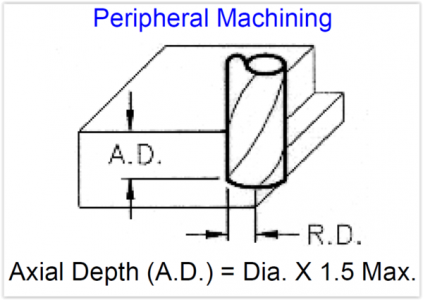I have chowdered up several end mills now. Probably time to actually learn something...
I am using a PM25 mill. I have a 1" cube of cold rolled steel. Need to take a 1/2" x 1/2" bite out of it. (End up with a fat "L" shape). Being a beginner I set up my 3/4" hogging carbide end mill for 1/2" down and 1/2" in. I mean, like how hard can this be? Just go slow and zip-po bang-go I have my bite taken.
Well, as you all can imagine, that doesn't work. A few more naive tries and I am reduced to having to ask.
How best to make this cut? What end mill? What rpm? What feed rate? Do I go down to the 1/2" depth and then across a bit at a time? Or across 1/2" and then down a bit at a time? Should I do both at the same time? How much is "a bit?" If I can't do 1/2" cuts, should I be able to do .1"? .01"? As I actually have about 20 such bites to take if each takes 50 slow runs, it is doable. But would prefer to have some sense there is not a factor of 10 faster way to do it. (Factor of 2 or 3 inefficiency is not problem--I'm just a hobbiest. Time is not money.)
"In theory there is no difference between theory and practice. In practice there is." Once I have my bite no one (I mean other than on this board) will see it was actually hard. The idea is so simple. Thanks for helping me figure out how to make in practice.
-Bill
I am using a PM25 mill. I have a 1" cube of cold rolled steel. Need to take a 1/2" x 1/2" bite out of it. (End up with a fat "L" shape). Being a beginner I set up my 3/4" hogging carbide end mill for 1/2" down and 1/2" in. I mean, like how hard can this be? Just go slow and zip-po bang-go I have my bite taken.
Well, as you all can imagine, that doesn't work. A few more naive tries and I am reduced to having to ask.
How best to make this cut? What end mill? What rpm? What feed rate? Do I go down to the 1/2" depth and then across a bit at a time? Or across 1/2" and then down a bit at a time? Should I do both at the same time? How much is "a bit?" If I can't do 1/2" cuts, should I be able to do .1"? .01"? As I actually have about 20 such bites to take if each takes 50 slow runs, it is doable. But would prefer to have some sense there is not a factor of 10 faster way to do it. (Factor of 2 or 3 inefficiency is not problem--I'm just a hobbiest. Time is not money.)
"In theory there is no difference between theory and practice. In practice there is." Once I have my bite no one (I mean other than on this board) will see it was actually hard. The idea is so simple. Thanks for helping me figure out how to make in practice.
-Bill

